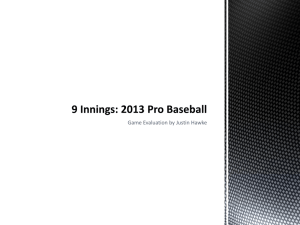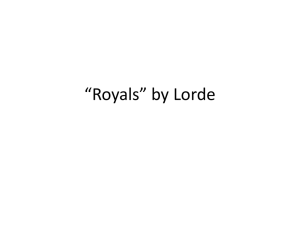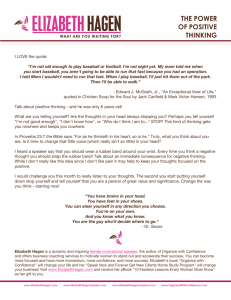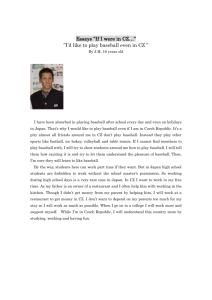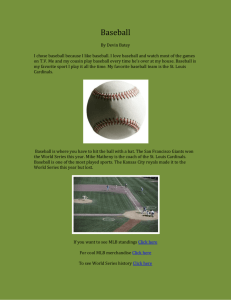Copyright 1990 The Sporting News Publishing Company
advertisement
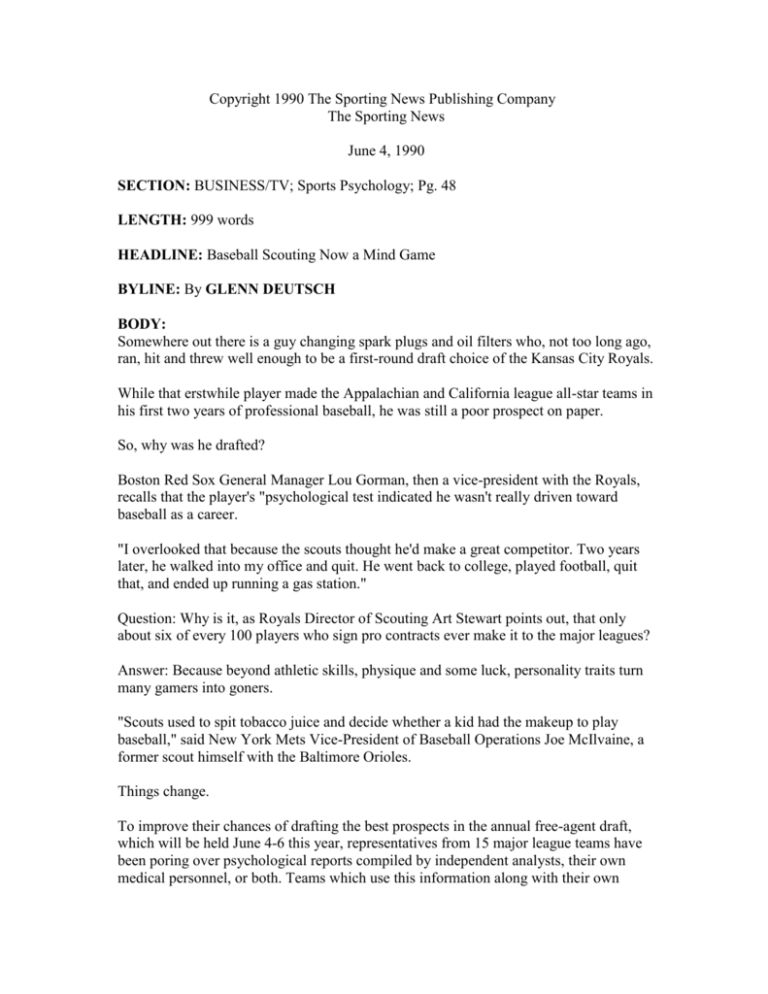
Copyright 1990 The Sporting News Publishing Company The Sporting News June 4, 1990 SECTION: BUSINESS/TV; Sports Psychology; Pg. 48 LENGTH: 999 words HEADLINE: Baseball Scouting Now a Mind Game BYLINE: By GLENN DEUTSCH BODY: Somewhere out there is a guy changing spark plugs and oil filters who, not too long ago, ran, hit and threw well enough to be a first-round draft choice of the Kansas City Royals. While that erstwhile player made the Appalachian and California league all-star teams in his first two years of professional baseball, he was still a poor prospect on paper. So, why was he drafted? Boston Red Sox General Manager Lou Gorman, then a vice-president with the Royals, recalls that the player's "psychological test indicated he wasn't really driven toward baseball as a career. "I overlooked that because the scouts thought he'd make a great competitor. Two years later, he walked into my office and quit. He went back to college, played football, quit that, and ended up running a gas station." Question: Why is it, as Royals Director of Scouting Art Stewart points out, that only about six of every 100 players who sign pro contracts ever make it to the major leagues? Answer: Because beyond athletic skills, physique and some luck, personality traits turn many gamers into goners. "Scouts used to spit tobacco juice and decide whether a kid had the makeup to play baseball," said New York Mets Vice-President of Baseball Operations Joe McIlvaine, a former scout himself with the Baltimore Orioles. Things change. To improve their chances of drafting the best prospects in the annual free-agent draft, which will be held June 4-6 this year, representatives from 15 major league teams have been poring over psychological reports compiled by independent analysts, their own medical personnel, or both. Teams which use this information along with their own scouting reports are the Angels, Astros, Blue Jays, Braves, Cubs, Expos, Indians, Mariners, Mets, Orioles, Padres, Phillies, Royals, Tigers and Twins. "We're trying to predict a kid's potential four or five years from now," said John Barr, the Orioles' scouting director. "That's when he's likely to experience his first real failures. We're looking for the possible weaknesses in how he'll handle himself." Most clubs rely on the Athletic Motivational Inventory (AMI) test, which consists of 190 multiplechoice questions designed to measure mental toughness, emotional control, selfconfidence, aggressiveness, determination, drive, coachability, conscientiousness, leadership, trust and responsibility. Many baseball personnel believe the first two traits are critical. McIlvaine said mental toughness and emotional control "change very little whether a player's 18 or 28." Confidence is next in order of importance. High scores are desirable in every characteristic except one. Overly responsible players, testers say, can be too guilt-prone to shake off mistakes. In actuality, borderline profiles don't sway teams if a prospect has great physical skills. "But if it's way below our average, we run like hell," said Stewart. Results can be astonishingly accurate. Last year's first-round draft picks averaged 17 points higher than all the rest in AMI-tested traits. The greatest difference was mental toughness, where the top 64 players (first three rounds) averaged 25 points higher. They also came in nine points below the mean in responsibility. Here are the most desirable personality profiles: * Pitchers need high emotional control and mental toughness, as do catchers, who also need leadership, drive and determination. * Middle infielders and center fielders, who tend to be smaller physically, need leadership and strong drive, both signs of an overachiever. * Sluggers, or outfielders, third basemen and first basemen, need strong self-confidence to overcome striking out. Here's a sample question measuring drive: "When I was young, I thought about breaking a sports record a) always, b) often, c) sometimes." (Give two points for A, one for B, none for C). Here's one on aggressiveness: "To be the most effective in competition, one should a) hate the opponents, b) respect them for their ability, c) not worry about them but concentrate on oneself." A player who answers C to that question would be considered more likely to slide around a shortstop or second baseman instead of knocking him down to try and break up a double play. The AMI was created by two sports psychologists, Bruce Ogilvie and Thomas Tutko, who fine-tuned the psychological test and then sold it to the Institute of Athletic Motivation in Redwood City, Calif., in the early 1970s. Scouts from the Major League Scouting Bureau administer the paper-and-pencil test to prospects in their homes. The test takes about an hour to complete and clubs pay about $ 5,000 each for the annual set of reports. The Royals spend about that much to screen half as many players on their own, using a standard psychological test adopted for baseball. It was designed by Reuben Stohs, a former minor league pitcher who played on and off in the St. Louis Browns organization from 1944 to 1956. Stohs said he began studying psychological because he was fascinated about how players like former New York Yankees pitcher Whitey Ford controlled anxiety. The Mets use the AMI and also have hired Caliper Corp. of Princeton, N.J., to do indepth profiles of 150 amateurs annually. Caliper also does about 30 interviews for the Orioles. The decision to test players usually rests with a scouting director or director of player development. Gorman, one of baseball's trailblazers in psychological testing in the 1970s, when he was director of player development for the Royals and later headed up their Baseball Academy, now works for a team, the Red Sox, that doesn't believe in the process. "The people here feel they get as much accurate information from having individual scouts dig into the boy's background," said Gorman. McIlvaine acknowledged that there is one major shortcoming with psychological testing. "It doesn't measure heart or courage or guts," he said. "You really have to see that on the ball field." SECTION: SPORTS BUSINESS/TV; Pg. 48 LENGTH: 213 words HEADLINE: Three Who Were Heads of Their Class BYLINE: GLENN DEUTSCH BODY: Occasionally, a major league baseball prospect is drafted higher than what his physical skills dictate because his mental outlook is so outstanding. Following are three players who were selected in the first round of last year's June free-agent draft because of that reason: Frank Thomas -- Most teams didn't think this first baseman was a Top 10 choice, but the New York Mets and Chicago White Sox did, and the Sox took Thomas with the seventh pick. "Whatever this guy has got, our test says he's going to maximize," said Herb Greenberg, Ph.D., a psychologist who works as a consultant for the Mets. "He's going to be everything his God-given talent will let him be." Alan Zinter -- The Mets chose this catcher with the 24th pick even though he had dubious defensive skills. "All his non-physical qualities were good and we thought he could hit," said Vice-President of Baseball Operations Joe McIlvaine. "We think he will be able to realize his talent with his non-physical ability." Brent Mayne -- Most clubs didn't consider him a first-rounder, but the Kansas City Royals made him the 13th selection. "He had one of the best profile tests we've ever administered," said Art Stewart, the Royals' scouting director. "He came off at 9.9, almost off the board."
